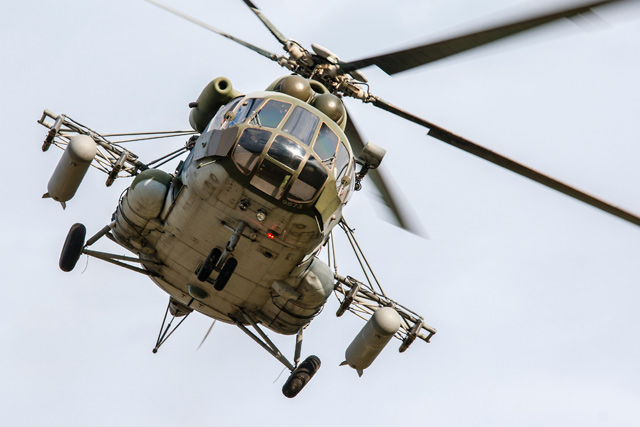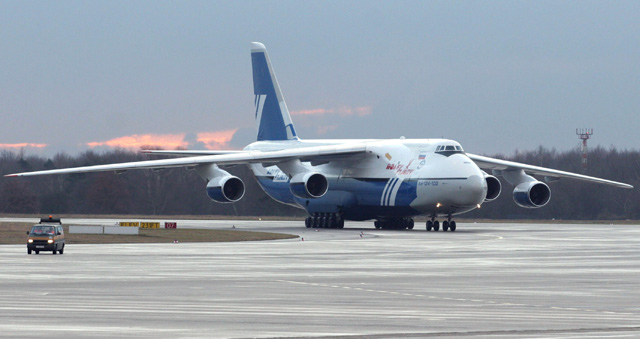Ever since Russia-backed forces began to take control of the Crimean peninsula at the end of February, a steady of escalation of sanctions by Ukraine against Russia has had increasingly negative effects on the aerospace sectors of both countries.
Since the collapse of the Soviet Union in 1991, the two countries’ industries had enjoyed an at-times contentious but largely productive relationship. The most recent round of embargoes placed on Russia by Ukrainian president Petro Poroshenko, however, will cut the links and cause collateral damage on both sides.
The latest developments can be traced back to 2005 and the election in Kiev of the pro-Western Viktor Yushchenko as president. Yushchenko declared at the time that the country aspired to eventual NATO membership, which triggered warning statements from then Russian defence minister Sergei Ivanov.
If Ukraine increased its co-operation with NATO, said Ivanov at the time, the co-production agreements that Ukraine has with Russia would be curtailed. If that were to happen, Ivanov predicted that Ukrainian defence enterprises would eventually go bankrupt “with all the ensuing consequences”.
When the Soviet Union collapsed and Ukraine became an independent state it inherited about one-third of the Soviet defence industrial complex, which made up about 70% of Ukraine’s overall industrial base. This meant that Ukraine’s economy became – and has remained – largely hostage to trends in the international defence market. Ukraine’s ability to make money in the defence business has been heavily dependent on Russian export sales and domestic procurement for Moscow’s armed forces.
And Ukraine can produce very few weapons indigenously. Ukrainian industry, and particularly the country’s large network of overhaul plants, remains dependent on Russian-made components.

Russia's Mi-17 features Ukrainian engines
AirTeamImages
At the same time Russia has depended on Kiev for many of the components that were produced in Ukraine during Soviet times. Co-production arrangements and defence trade between the two countries involved 1,330 Russian and Ukrainian enterprises. Under this system, Russia accounted for 22.8% of Ukrainian defence imports, and 50-60% of Ukrainian exports went to the Russian market.
Not surprisingly, Russia has for years tried to cut ties with Ukraine on the grounds that having its defence industrial sector maintaining so many links with Ukraine was a danger to Moscow’s national security. Russian defence procurement and sales, and revenue it depends on to fund its own defence research and development projects, would become subject to “NATO's moods”, said a Russian official, in response to Ukraine's NATO ambitions in 2005. Russia, he said, could not bet its future on “Brussels' calls for mutual partnership and assurances of loyalty”.
As Moscow has tried to reduce its dependence on Ukraine, the revenue that Ukraine earns from Russia’s export sales has been falling. Ukrainian factories have delivered avionics and weapons for Sukhoi Su-30MKI fighters sold to India, and the Su-27SK and Su-30-MKK models exported to China, but total export sales are far less than they were in 1991.
In 1991, Russia sold the first of several batches of Su-27 fighters to China. At the time, production of the initial batch of Su-27SKs for Beijing involved products from 44 separate Ukrainian enterprises. Today, fewer than 14 Ukrainian factories produce components for the Su-30MKK models sold to China. And only two Ukrainian enterprises have produced parts for the Su-30MKIs that are built at the Hindustan Aeronautics Ltd (HAL) plant in Nashik, India under a licensed co-production agreement between Moscow and New Delhi.
What remains of the co-operative arrangements between Ukrainian and Russian industry has been cut off and there seems to be very little chance of reconciliation – unless Russian-backed troops withdraw from Crimea and eastern Ukraine and there is a major change in the political order in Moscow.
The consequences of this separation of two long-standing partner countries are not insignificant for Russia, but they perhaps have a harsher immediate impact on Ukraine’s industry. Ukraine exports a number of big ticket items to Russia (Motor Sich engines for the Mil-17 helicopter, for example) and without this market provided by sales made by Moscow, some of Ukraine’s major aerospace companies will have a hard time surviving in the long term unless they can construct a new customer base in a fairly short timeframe.
Aside from the Motor Sich engine production centre, another potential casualty is the Antonov design bureau in Kiev, as well as its associated production plants.
Antonov receives very little funding from the Ukrainian government and its programmes with Russia – involving both the support and modernisation of the An-124 Ruslan heavy cargo lifter – are one of its few sources of revenue.
Motor Sich receives almost all of its income from sales of engines for helicopters being produced in Russia. The Mil-17 and other models have become some of the biggest-selling products in Russia’s aerospace industry and the income that enters Ukraine from engine sales amounts to hundreds of millions of dollars.

Antonov's success as a business relies heavily on An-124 support and modernisation
Rex Features
“If all trade with Russia is curtailed then these and other Ukrainian firms are likely to become real invalids, so to speak, and really incapable of surviving,” said an aerospace industry analyst in Moscow. “There are just no substitute markets for the Russian customers which Ukraine has had since the end of Soviet times.”
On the Russian side, the job of replacing Ukrainian suppliers with alternative sources is not a simple one.
Russia’s political leadership recognises that weapons systems remain one of the few manufactured products that countries are interested in procuring from Russia. The defence sector has been told to begin producing components that it used to buy from Ukraine. But trying to build a new supplier base from scratch will take enormous amounts of time and money.
The Kommersant daily newspaper in Moscow has reported the director of the Russian Federal Space Agency (Roscosmos) as stating that it could cost upwards of Rb33 billion ($890 million) to re-create Ukrainian production lines in Russia. And these new production lines would not exist for several years because of the time required to establish them. The earliest that production could begin would be in 2018. In the meantime, the Russian space programme would suffer some considerable slowdowns in order to conserve booster rockets already in its inventory.
Moreover, the process of building new manufacturing plants in Russia involves considerable opportunity cost.
Roscosmos documents made available to the Russia press state that these new production lines would be funded by a mechanism not unlike the proverbial “robbing Peter to pay Paul” method. About Rb2.3 billion would be deducted from the federal space programme budget, Rb23.2 billion would come out of the national defence modernisation programme and Rb7.6 billion would be set aside from state federal investment funding.
“It means that [Russian President Vladimir] Putin’s efforts to destroy Ukraine are creating nearly as many problems back home here in Russia as they are in Kiev,” says a Moscow defence specialist. “There are also very few examples of Russia actually following through on plans to replace major production lines in Ukraine with newly built analogues in Russia. For years Russian industry officials have insisted that they had concrete plans to build a new factory that would begin producing all of the helicopter engines that have to be purchased from Ukraine, but these plans never get very far beyond the public declarations due to the expense and time involved,” he says.
Ultimately, the situation could cause more problems for Russia's industry than Ukraine's. Ukraine's industry will suffer immediate difficulties, but Poland and other NATO nations are already in the process of trying to engage Ukrainian industry in order to compensate for the loss of this Russian market. Eventually, Ukraine’s industrial base could re-orient itself towards a new set of customers – just as the country's economy is pivoting away from Russia with the signing of the EU Association Agreement in June.
Russia, on the other hand, has no place to turn to. It will continue to sell to its traditional partners in China and India, but its status now as a state that is becoming increasingly isolated dims its prospects for breaking into new markets. Products designed for non-traditional, foreign customers, such as the Sukhoi Superjet, will probably go out of production and will become unsupportable because so many of the components needed to build and operate this aircraft are now embargoed.
The separation of these long-intertwined industrial bases promises to be fraught with disruptions on both sides. The argument could be made that this was an inevitable consequence of Kiev’s decision to move out of Russia’s orbit and become an EU partner. Ukraine’s industrial future would lose links to Russia, regardless of the current conflict.
Russia’s future, however, is far less clear. Its major new-generation programmes have had problems with both cost and following planned timelines. It will now suffer from both the embargo on all defence exports from Ukraine, and also the embargoes put in place by the USA, the EU and other countries.
“A lot of the future of Russian programmes like the [Sukhoi] T-50 [fifth-generation fighter] depends on the ability to purchase commercial-off-the-shelf components from the US and Europe,” says a Ukrainian defence enterprise director. “The question is not how Moscow can continue on with what they buy from Ukraine, but how they can survive without what they used to buy from the US and Europe.”
Russia's reliance on Ukrainian industry
• Most Russian helicopters are fitted with engines from the Motor Sich factory in Zaporozhye. Russia depends on the Ukrainian supplier for most of the older model Mil Mi-8, Mi-24 and Mi-26 helicopters, and the more contemporary Mi-28, plus the Kamov Ka-27, Ka-50, Ka-52 and Ka-60 models.
• Motor Sich also builds engines for the Beriev Be-200 amphibious twinjet and the Yakovlev Yak-130 jet combat trainer.
• Ukraine’s Zorya-Mashproekt produces the main turbines for capital warships and gas turbine installations, and for propulsion units on the Murena-class hovercraft. Ukraine is the only production centre at present for this type of propulsion system.
• Of 20 types of missiles in Russia’s inventory, 12 were designed at the Yuzhnoe design bureau in Dnepropetrovsk and then built at the Yuzhmash plant. These include the RS-20V Voevoda intercontinental ballistic missile, and the combat railroad missile complexes built at Pavlograd.
• Kiev’s Artema plant has been the sole producer of the Vympel R-27 (AA-10) and R-73 (AA-11) air-to-air missile models since the Soviet period. Originally it was to have produced the R-77/RVV-AE (AA-12) air-to-air missile, but these plans were shelved with the breakup of the Soviet Union.
• The Kremenchug automotive factory currently builds KRAZ trucks for the Almaz-Antey S-300 surface-to-air missile systems, which have been one of Moscow’s best-selling export items.
• The Novokramatorsk plant makes part of the S-300’s radar system, chiefly the radar towers, and the L’viv radar and electronics plant produces a large portion of the electronics for these systems – close to 70%. The L’viv plant also has a major role in the production of electronics for the S-400, the S-300’s more capable follow-on model.
• Kiev’s Luch Design Bureau is the sole producer of the lattice-control fin tail section used on the RVV-AE (AA-12) active radar homing air-to-air missile. This system was almost entirely developed not in Moscow, but at the Kharkhiv aviation research complex.
• The Khmelnitskiy-based Novator radar and avionics plant produces a number of components for the MiG-29 and Su-27 fighter aircraft, particularly those systems that are part of the N001 radar and the fire-control system for the Su-27.
Source: Flight International



















